|

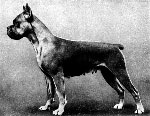 An adult Boxer typically weighs between 55 and 70 lbs (25 and 32 kg). Adult male Boxers are between 23 and 25 in. (57 nand 63 cm) tall at the withers; adult female are between 21 to 23 ½ in. (53 and 60 cm). Docking of the tail remains popular, although cropping of the ears is gradually declining in popularity and both are now prohibited in many European breed standards and are slowly being banned in many countries. As of March, 2005,
the AKC changed its standard to allow the showing of
uncropped Boxers. An adult Boxer typically weighs between 55 and 70 lbs (25 and 32 kg). Adult male Boxers are between 23 and 25 in. (57 nand 63 cm) tall at the withers; adult female are between 21 to 23 ½ in. (53 and 60 cm). Docking of the tail remains popular, although cropping of the ears is gradually declining in popularity and both are now prohibited in many European breed standards and are slowly being banned in many countries. As of March, 2005,
the AKC changed its standard to allow the showing of
uncropped Boxers.
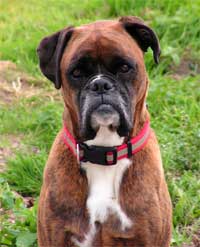 Color: Boxers are typically either fawn or brindle, often with a white underbelly and white on the front or all four feet. The whiteness, called flashiness, often extends onto the shoulders or face. White Boxers account for approximately 25% of all Boxers. Boxers with white coloring covering more than one-third of their coat do not meet the Boxer breed standard by the American Kennel Club. Some brindled Boxers are so dark as to appear black but really the stripes are so close together that they are considered reverse brindles. Black Boxers do not exist. In the UK, fawn Boxers are typically richer in color and are called "Red". Color: Boxers are typically either fawn or brindle, often with a white underbelly and white on the front or all four feet. The whiteness, called flashiness, often extends onto the shoulders or face. White Boxers account for approximately 25% of all Boxers. Boxers with white coloring covering more than one-third of their coat do not meet the Boxer breed standard by the American Kennel Club. Some brindled Boxers are so dark as to appear black but really the stripes are so close together that they are considered reverse brindles. Black Boxers do not exist. In the UK, fawn Boxers are typically richer in color and are called "Red".
Flashy Boxers: The Boxer breed standard stipulates that two-thirds (roughly 67%) of the body be either fawn or brindle in color. Some Boxers have white markings that do not meet the standard and are therefore mostly or entirely white. Contrary to popular opinion, white Boxers are neither albino (lacking pigment in the skin and eyes), nor rare. Genetic analysis indicates that as many as one-quarter (25%) of all Boxers are white.

Friendly and Fierce: The character of the Boxer is of the greatest importance and demands the most careful attention. He is renowned for his great love and faithfulness to his master and household, his alertness, and fearless courage as a defender and protector. The 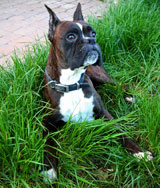 Boxer is docile but distrustful of strangers. He is bright and friendly in play but brave and determined when roused. His intelligence and willing tractability, his modesty, and cleanliness make him a highly desirable family dog and cheerful companion. He is the soul of honesty and loyalty. He is never false or treacherous even in his old age. Boxer is docile but distrustful of strangers. He is bright and friendly in play but brave and determined when roused. His intelligence and willing tractability, his modesty, and cleanliness make him a highly desirable family dog and cheerful companion. He is the soul of honesty and loyalty. He is never false or treacherous even in his old age.
Obedience Training: Boxers are a bright, energetic and playful breed and tend to be very good with children. It's best if obedience training is started early since they also have a strong personality and therefore can be harder to train when older. Boxers earned a slight reputation of being "headstrong," which can be related to poor obedience-training. This, plus their strength might present a challenge for a first-time dog owner. It is also equally true that Boxers have a very long puppyhood and adolescence. They are not considered fully mature until age three, one of the longest times in dogdom, and thus need the early training to keep their high energy from wearing the owner out.
Socialization: The Boxer is not an aggressive or vicious dog, but it needs socialization to tolerate other dogs
well. His sometimes over-protective, territorial and dominating attitude,
most intense in males, can be problematic. Boxers are very 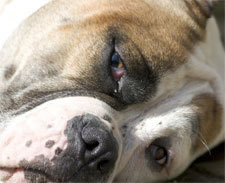 patient with smaller dogs but can be aggressive
with larger dogs of the same sex.
A poorly bred or trained dog is capable of seriously injuring or killing other animals. patient with smaller dogs but can be aggressive
with larger dogs of the same sex.
A poorly bred or trained dog is capable of seriously injuring or killing other animals.
Guard Dogs and Guide Dogs: Boxers' suspicion of strangers, alertness, agility, and strength make them formidable
guard dogs. They also sometimes appear at dog agility trials and flyball events. Before dog fighting was made illegal, Boxers were often used in dog
fights.
These strong and intelligent animals have even been sometimes
used as guide dogs for the blind
and police dogs in K9 units in place
of the typical German Shepherd. The versatility of Boxers was recognized by the military, which used them as valuable messenger dogs, pack carriers, and
attack and guard
dogs in times of war.

Boxer Background: The ancestors of this breed were the German Bullenbeisser, a dog of Mastiff descent, and the English Bulldog. The Bullenbeisser had been working as a hunting dog for centuries, employed in the pursuit of bear, wild boar, and deer. Its task was to seize the prey and hold it until the hunters arrived. In later years, faster dogs were favored and the Bullenbeisser grew smaller and became known as the Brabanter.
In the late 19th century, the Brabanter was crossed with an English Bulldog to start the line that would become the modern Boxer. In 1894, three Germans by the name of Roberth, Konig, and Hopner decided to stabilize the breed and put it on exhibition at a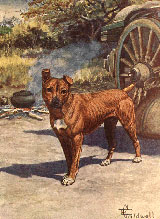 dog show. This was done in Munich in 1895, and the next year they founded the first Boxer Club. dog show. This was done in Munich in 1895, and the next year they founded the first Boxer Club.
The breed was introduced to other parts of Europe in the late 1800's and to the United States around the turn of the century. The American Kennel Club (AKC) recognized the first Boxer champion in 1915.
During World War I, the Boxer was co-opted for military work, acting as a valuable messenger dog, pack-carrier, attack dog, and guard dog. It was not until after World War II that the Boxer became popular around the world. Boxer mascots, taken home by returning soldiers, introduced the dog to a much wider audience and it soon became a favorite as a companion animal, as a show dog, and as a guard dog.
What's in a Name: The name "Boxer" is supposedly derived from this breed's tendency to begin a fight by standing on its hind legs and "boxing" with its front paws. According to Andrew H. Brace on his "Pet owner's guide to the Boxer" this theory is the least plausible explanation, claiming it's unlikely that a nation so permeated with nationalism like Germany would give to one of its most famous breeds a name so obviously anglicized. Brace states that there exist many other theories to explain the origin of the breed name, some claiming the smaller Bullenbeisser (Brabanter) were also known as "Boxl" and that Boxer is just a corruption of that word.
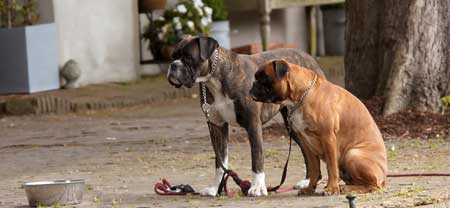
Health: Boxers are prone to develop "cancers, progressive retinal atrophy, torsion (bloat), epilepsy, bleeding disorders, intestinal problems, breathing difficulties from sinus infections," heart murmurs and ailments of the joints, such as arthritis and hip dysplasia, although most good breeders test their breeding stock and the incidence is slowly decreasing. Problems of the thyroid gland, while rare, often go unnoticed. This does not directly harm the Boxer, but early attention to the condition can prolong the life of the dog.
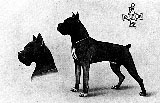 White Boxers: White Boxers allegedly have a tendency to develop deafness at a rate much higher than other Boxers. Some studies indicate 30-40% of all white Boxers are deaf in one or both ears, but the unbiased nature of these studies is challenged. White Boxers: White Boxers allegedly have a tendency to develop deafness at a rate much higher than other Boxers. Some studies indicate 30-40% of all white Boxers are deaf in one or both ears, but the unbiased nature of these studies is challenged.
There have been active breeder interventions trying
to diminish the popularity of white Boxers, and because the breed standard stipulates that two-thirds
of the body be either fawn or brindle in color, many white Boxers are euthanised at birth by commercial breeders, although this practice was more common in the past than it is today.
Popularity in America: Based on 2005 American Kennel Club statistics, Boxers are the seventh most popular breed of dog in the United States with approximately 37,268 new registrations during the year.
All text is available under the terms
of the GNU Free Documentation License
|
